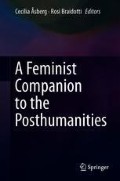Notes
- 1.
- 2.
This assemblage resonates with Donna Haraway’s notion of the material-semiotic actor, a conception that attends to the relations and forces that take place within the very process or tissue of making (1991, 210).
- 3.
In her rethinking of art in a posthuman context, Patricia McCormack notes that, “The onus is neither on the artwork nor the mythologized intent of the artist, but the subject’s witness’s coming forward or path taken” (2012, 45).
- 4.
- 5.
Hester is referring to Nick Bingham’s (2006) notion of “nonhuman friendship” as a “capacity to learn to be affected by an out-side.”
- 6.
Thiele sees a congruence between the model of ontology and ethics, which appears in Karen Barad and the Deleuzian inspired formula “ontology – ethics” in the figure of “becoming.” She argues that in Deleuze’s conception of “becoming” the two domains – ontology and ethics – “touch up/on each other” in such a way that “both sides become-different from what either ‘ontology’ or ‘ethics’ in a classical sense were meant to be” (2014, 207). However, Thiele is also concerned that thought-practices “are always/already implicated in and concerned with world(ing),” commenting that an affirmative politics of difference involves “a thought-practice in which concepts are not abstraction from the world, but an active force of this world” (2014, 203). This begs the question of how the politics of difference are played out in and through the Deleuzian figure of the rhizome.
- 7.
- 8.
See an extended discussion of this refiguration of createdness in the chapter “The artist in a post-human world?” (Bolt 2011).
References
Australian Centre for contemporary art. 2010. In Please leave these windows open overnight to enable the fans to draw in cool air during the early hours of the morning. At https://www.accaonline.org.au/exhibition/bianca-hester-please-leave-these-windows-open-overnight-enable-fans-draw-cool-air-during>. Accessed 1 June 2015.
Barad, Karen. 2007. Meeting the Universe halfway: Quantum physics and the entanglement of matter and meaning. Durham, NC: Duke University Press.
Benjamin, Andrew. 2010. Stalling: Notes on the work of Bianca Hester. In Please leave these windows open overnight to enable the fans to draw in cool air during the early hours of the morning. Melbourne: Australian Centre for Contemporary Art.
Bingham, Nick. 2006. Bees, butterflies and bacteria: Biotechnology and the politics of nonhuman friendship. Environmental Planning 38(3): 483–496.
Bolt, Barbara. 2004. Art beyond representation: The performative power of the image. London: I.B. Tauris.
Bolt, Barbara. 2010. Unimaginable happenings: Material movements in the plane of composition. In Deleuze and Contemporary Art, eds. Stephen Zepke, and Simon O’Sullivan, 266–285. Edinburgh: Edinburgh University Press.
Bolt, Barbara. 2011. Heidegger reframed: Interpreting key thinkers for the arts. London: I.B. Tauris.
Buckley, Jennifer. 2013. The ghosts of the Avant-Garde(s): Exorcising experimental theater and performance. Comparative Drama 47(4). http://www.questia.com/library/journal/1G1-360679909/james-m-harding-the-ghosts-of-the-avant-garde-s. Accessed 1 May 2014.
Colman, Felicity. 2005. Rhizome. In The Deleuze dictionary, ed. Adrian Parr, 211–213. Edinburgh: Edinburgh University Press.
Deleuze, Gilles, and Felix Guattari. 1987. Thousand plateaus: Capitalism and schizophrenia. Translation and foreword B. Massumi, Minneapolis: University of Minnesota Press.
Deleuze, Gilles, and Felix Guattari. 1994. What is philosophy? New York, NY: Columbia University Press.
Ednie-Brown, Pia. 2012. Supervising emergence: Adapting ethics approval frameworks towards research by creative project. In Supervising practices for postgraduate research in art, architecture and design, eds. Brent Allpress, Robyn Barnacle, Lesley Duxbury, and Elizabeth Grierson, 103–116. Rotterdam: Sense Publishers.
Grosz, Elizabeth. 2002. A Politics of imperceptibility: A response to ‘anti-racism, multiculturalism and the ethics of identification’. Philosophy and Social Criticism 28(4): 463–472.
Haraway, Donna. 1988. Situated knowledges: The science question in feminism and the privilege of partial perspective. Feminist Studies 14(3): 575–599.
Haraway, Donna. 1991. Simians, Cyborgs, and Women: The Reinvention of Nature. London: Free Association
Heidegger, M. 1977. The question concerning technology and other essays, translated with an introduction by William Lovitt, 115–154. New York and London: Garland Publishing.
Heidegger, Martin. 1977. The question concerning technology and other essays. Trans. W. Lovitt. New York and London: Garland Publishing.
Hester, Bianca. 2013. Unpublished conference paper. ‘Shaggy Edge of Open’, Art Association of Australia and New Zealand, AAANZ conference, Melbourne, December 2013.
Hester, Bianca. 2014. Leave the windows open. Australian Centre for Contemporary Art. At https://www.accaonline.org.au/leave-windows-open-rewind-2010. Accessed 5 Jul 2015.
MacCormack, Patricia. 2012. Posthuman ethics: Embodiment and cultural theory. London: Ashgate.
Marks, John. 2005. Ethics. In The Deleuze dictionary, ed. Adrian Parr, 85–86. Edinburgh: Edinburgh University Press.
Morton, Timothy. 2010. Morton, The Ecological thought. Cambridge, MA: Harvard University Press.
Murray, Philippa. 2012. A Moment in movement: the indeterminate interior. Presented Interior: a State of Becoming, a symposium presented by IDEA: Interior Design, Interior Architecture Educators Association, Perth, 2012. At http://idea-edu.com/symposiums/2012-interior-a-state-of-becoming/2012-symposium-proceedings-full-papers/. Accessed 1 May 2014.
Sauvagnargues, Anne. 2013. Deleuze and art. Trans. Samantha Bankston. London: Bloomsbury.
Thiele, Kathrin. 2014. Ethos of diffraction: New paradigms for a (post)humanist ethics. Parallax 20(3):202–2016.
Varela, Francesco. 1999. Ethical know-how: Action, wisdom and cognition. Stanford, CA: Stanford University Press.
Verwoert, Jan. 2009. Personal support: How to care? In Support structures. Berlin and New York: Sternberg Press.
Zylinska, Joanna. 2014. Minimal ethics for the anthropocene. Ann Arbor, MI: Open Humanities Press, Michigan Publishing University of Michigan Library.
Acknowledgements
I would like to thank Bianca Hester for her generosity in the preparation of this essay. I very much appreciated her responsiveness and critical engagement with the text and for permission to reproduces the images.
Author information
Authors and Affiliations
Corresponding author
Editor information
Editors and Affiliations
Rights and permissions
Copyright information
© 2018 Springer International Publishing AG, part of Springer Nature
About this chapter
Cite this chapter
Bolt, B. (2018). Couch Grass: Ethics of the Rhizome. In: Åsberg, C., Braidotti, R. (eds) A Feminist Companion to the Posthumanities. Springer, Cham. https://doi.org/10.1007/978-3-319-62140-1_6
Download citation
DOI: https://doi.org/10.1007/978-3-319-62140-1_6
Published:
Publisher Name: Springer, Cham
Print ISBN: 978-3-319-62138-8
Online ISBN: 978-3-319-62140-1
eBook Packages: Religion and PhilosophyPhilosophy and Religion (R0)

